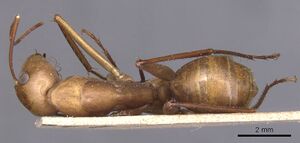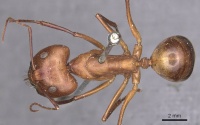Camponotus mystaceus
| Camponotus mystaceus | |
|---|---|

| |
| Scientific classification | |
| Kingdom: | Animalia |
| Phylum: | Arthropoda |
| Class: | Insecta |
| Order: | Hymenoptera |
| Family: | Formicidae |
| Subfamily: | Formicinae |
| Tribe: | Camponotini |
| Genus: | Camponotus |
| Species: | C. mystaceus |
| Binomial name | |
| Camponotus mystaceus Emery, 1886 | |
| Subspecies | |
| |
Identification
Distribution
Latitudinal Distribution Pattern
Latitudinal Range: -20.07335302° to -33.88333°.
| North Temperate |
North Subtropical |
Tropical | South Subtropical |
South Temperate |
- Source: AntMaps
Distribution based on Regional Taxon Lists
Afrotropical Region: Botswana, Namibia, South Africa (type locality), Zimbabwe.
Distribution based on AntMaps
Distribution based on AntWeb specimens
Check data from AntWeb
Countries Occupied
| Number of countries occupied by this species based on AntWiki Regional Taxon Lists. In general, fewer countries occupied indicates a narrower range, while more countries indicates a more widespread species. |

|
Estimated Abundance
| Relative abundance based on number of AntMaps records per species (this species within the purple bar). Fewer records (to the left) indicates a less abundant/encountered species while more records (to the right) indicates more abundant/encountered species. |

|
Biology
Castes
   
| |
| . | |
Nomenclature
The following information is derived from Barry Bolton's Online Catalogue of the Ants of the World.
- mystaceus. Camponotus mystaceus Emery, 1886: 356, pl. 17, fig. 3 (s.w.m.) SOUTH AFRICA.
- Type-material: 1 syntype major worker, syntype minor workers (number not stated, “some”), 2 syntype males.
- Type-locality: South Africa: Cape of Good Hope (L. Péringuey).
- Type-depository: MSNG.
- Arnold, 1924: 675 (q.).
- Combination in C. (Myrmopsamma): Forel, 1914a: 261.
- Status as species: Dalla Torre, 1893: 244; Emery, 1896d: 370 (in list); Forel, 1910f: 27; Arnold, 1922: 674; Wheeler, W.M. 1922a: 988; Emery, 1925b: 71; Marsh, 1986: 342; Bolton, 1995b: 112.
- Distribution: Botswana, Namibia, South Africa.
- Current subspecies: nominal plus exsanguis, kamae.
Description
References
- Arnold, G. 1924. A monograph of the Formicidae of South Africa. Part VI. Camponotinae. Ann. S. Afr. Mus. 14: 675-766 (page 675, queen described)
- Emery, C. 1886b. Alcune formiche africane. Bull. Soc. Entomol. Ital. 18: 355-366 (page 356, pl. 17, fig. 3 soldier, worker, male described)
- Forel, A. 1914a. Le genre Camponotus Mayr et les genres voisins. Rev. Suisse Zool. 22: 257-276 (page 261, Combination in C. (Myrmopsamma))
References based on Global Ant Biodiversity Informatics
- Arnold G. 1924. A monograph of the Formicidae of South Africa. Part VI. Camponotinae. Annals of the South African Museum 14: 675-766.
- Botes, A., M.A. McGeoch, H.G. Robertson, A. van Niekerk, H.P. Davids and S.L. Chown. 2006. Ants, altitude and change in the northern Cape Floristic Region. Journal of Biogeography 33:71-90
- Emery C. 1886. Alcune formiche africane. Bullettino della Società Entomologica Italiana 18: 355-366.
- Forel A. 1910. Zoologische und anthropologische Ergebnisse einer Forschungsreise im westlichen und zentralen Südafrika ausgeführt in den Jahren 1903-1905 von Dr. Leonhard Schultze. Vierter Band. Systematik und Tiergeographie. D) Formicidae. Denkschriften der Medizinisch-Naturwissenschaftlichen Gesellschaft zu Jena 16: 1-30.
- IZIKO South Africa Museum Collection
- Koch F., and K. Vohland. 2004. Ants along a southern African transect - a basis for biodiversity change monitoring (Insecta, Hymenoptera, Formicidae). Zoosystematics and Evolution 80(2): 261-273.
- Marsh A. C. 1985. Forager abundance and dietary relationships in a Namib Desert ant community. S. Afr. J. Zool. 20: 197-203.
- Marsh A. C. 1986. Ant species richness along a climatic gradient in the Namib Desert. Journal of Arid Environments 11: 235-241.
- Marsh A. C. 1986. Checklist, biological notes and distribution of ants in the central Namib Desert. Madoqua 14: 333-344.
- Wheeler W. M. 1922. Ants of the American Museum Congo expedition. A contribution to the myrmecology of Africa. VIII. A synonymic list of the ants of the Ethiopian region. Bulletin of the American Museum of Natural History 45: 711-1004

